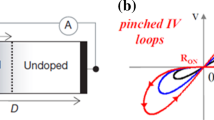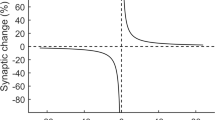Abstract
It is now widely accepted that memristive devices are promising candidates for the emulation of the behavior of biological synapses in neuromorphic systems. This is mainly because of the fact that like the strength of synapse, memristance of the memristive device can be tuned actively for example by the application of voltage or current. In addition, it is also possible to fabricate high density of memristive devices through the nano-crossbar structures. In this paper, we will show that there are some problems associated with memristive devices, which are playing the role of biological synapses. For example, we show that the variation rate of the memristance depends completely on the initial state of the device, and therefore, it can change significantly with time during the learning phase. This phenomenon can degrade the performance of learning methods like spike timing-dependent plasticity and cause the corresponding neuromorphic systems to become unstable. We also illustrate that using two serially connected memristive devices with different polarities as a synapse can somewhat fix the aforementioned problem.








Similar content being viewed by others
References
Strukov DB, Snider GS, Stewart DR, Williams RS (2008) The missing memristor found. Nature 453:80–83
Chua LO (1971) Memristor: the missing circuit element. IEEE Trans Circuit Theory CT–18(5):507–519
Jo SH, Chang T, Ebong I, Bhadviya BB, Mazumder P, Lu W (2010) Nanoscale memristor device as synapse in neuromorphic systems. Nano Letter 10(4):1297–1301
Cantley KD, Subramaniam A, Stiegler HJ, Chapman RA, Vogel EM (2011) Hebbian learning in spiking neural networks with nanocrystalline silicon TFTs and memristive synapses. IEEE Trans Nanotechnol 10(5):1066–1073
Pershin YV, Di Ventra M (2012) Neuromorphic, digital, and quantum computation with memory circuit elements. Proc IEEE 100(6):2071–2080
Snider G, Amerson R, Carter D, Abdalla H, Qureshi MS, Leveille J, Versace M, Ames H, Patrick S, Chandler B, Gorchetchnikov A, Mingolla E (2011) From synapses to circuitry: using memristive memory to explore the electronic brain. IEEE Comput 44(2):21–28
Kavehei O, Al-Sarawi S, Cho KR, Iannella N, Kim SJ, Eshraghian K, Abbott D (2011) Memristor-based synaptic networks and logical operations using in-situ computing. In: Seventh international conference on intelligent sensors, sensor networks and information processing (ISSNIP), pp 137–142, December 2011
Snider G (2008) Spike-timing-dependent learning in memristive nanodevices. In: IEEE international symposium on nanoscale architectures, pp 85–92, June 2008
Merrikh-Bayat F, Bagheri Shouraki S (2013) Memristive neuro-fuzzy system. IEEE Trans Cybern 43(1):269–285
Pickett MD, Strukov DB, Borghetti JL, Yang JJ, Snider GS, Stewart DR, Williams RS (2009) Switching dynamics in titanium dioxide memristive devices. J Appl Phys 106:074508
Hebb DO (1949) The organization of behavior. Wilew, New York
Zamarreo-Ramos C, Camuas-Mesa L, Prez-Carrasco JA, Masquelier T, Serrano-Gotarredona T, Linares-Barranco B (2011) On spike-timing-dependent plasticity, memristive devices, and building a self-learning visual cortex. Front Neurosci 5(26)
Merrikh-Bayat F, Bagheri Shouraki S (2011) Memristor crossbar-based hardware implementation of the IDS method. IEEE Trans Fuzzy Syst 19(6):1083–1096
Merrikh-Bayat F, Bagheri Shouraki S, Paeen Afrakoti IE (2013) Bottleneck of using a single memristive device as a synapse. Neurocomputing 115:166–168
Bi G, Poo M (1998) Synaptic modifications in cultured hippocampal neurons: dependence on spike timing, synaptic strength, and postsynaptic cell type. J Neurosci 18(24):10464–10472
Bi G, Poo M (2001) Synaptic modification by correlated activity: hebbs postulate revisited. Ann Rev Neurosci 24(1):139–166
Joglekar YN, Wolf SJ (2009) The elusive memristor: properties of basic electrical circuits. Eur J Phys 30(4):661–675
Chang T, Jo S-H, Kim K-H, Sheridan P, Gaba S, Lu W (2011) Synaptic behaviors and modeling of a metal oxide memristive device. Appl Phys A 102:857–863
Eshraghian K, Kavehei O, Cho K-R, Chappell JM, Iqbal A, Al-Sarawi SF, Abbott D (2012) Memristive device fundamentals and modeling: applications to circuits and systems simulation. Proc IEEE 100(6):1991–2007
Author information
Authors and Affiliations
Corresponding author
Rights and permissions
About this article
Cite this article
Merrikh Bayat, F., Shouraki, S.B. Nonlinear behavior of memristive devices during tuning process and its impact on STDP learning rule in memristive neural networks. Neural Comput & Applic 26, 67–75 (2015). https://doi.org/10.1007/s00521-014-1697-7
Received:
Accepted:
Published:
Issue Date:
DOI: https://doi.org/10.1007/s00521-014-1697-7




